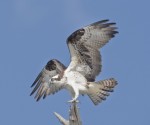
Last Saturday, the Stanislaus Audubon Society conducted its annual LaGrange/Waterford Christmas bird count. The count has been an annual event for well over thirty years, and usually tallies over 130 species and tens of thousands of individual birds.
This year was different. Count compiler Jim Gain’s preliminary estimate of 112 species was the lowest total in over twenty years, and the total number of individual birds was also way down.
Prior to the count, Gain had scouted the count circle, a fifteen mile diameter area within which the count takes place. What he saw was not encouraging. Canals, ditches, ponds, pools and other places which generally held both water and waterfowl were bone dry. That meant that not only would ducks be hard to find, but so would shorebirds and wading birds. Gain hoped for the best, but knew that without water, the likelihood for a low count total increased dramatically.
Most local birders were aware of the dry conditions, and made a special effort to scour places like Turlock Lake and Modesto Reservoir for the many species of birds dependent on water, but even those locations were remarkably barren of the usual bird species and numbers.
The LaGrange/Waterford count wasn’t the only one with remarkably low numbers. The Oakland count, which features hundreds of volunteer birders and a wide variety of habitats, also produced notably fewer birds than usual.
The ongoing drought is the most likely explanation for the low numbers of birds. According to the California Weather Blog, 2013 is likely to be California’s driest year on record by a considerable margin. Though the drought is doubtless a factor in the low numbers, one would think that locations like Turlock Lake and the San Francisco Bay would have featured more birds than counters tallied. There may well be other factors than the dry weather involved in the low numbers.
Whatever the reasons, the Audubon Christmas Count provides scientists with one of the largest and longest ongoing studies of wildlife and weather in the world. Though it’s almost entirely an amateur production, the data accumulated every year have provided long-term trends and important information available nowhere else.
Birds are one of the most sensitive indicators of the state of the environment, and low numbers sometimes can be attributed to factors other than the weather. When birders noticed steep declines in the numbers of Bald Eagles, Osprey, and Peregrine Falcons, ensuing research showed the problem was DDT, which was subsequently banned, not just because of the harm to birds, but because of potential harm to people.
Local birders will add more information to the Audubon database on January 5, when they count birds on the west side of Stanislaus County. And most of them would be more than happy to count birds on a wet and rainy day.
